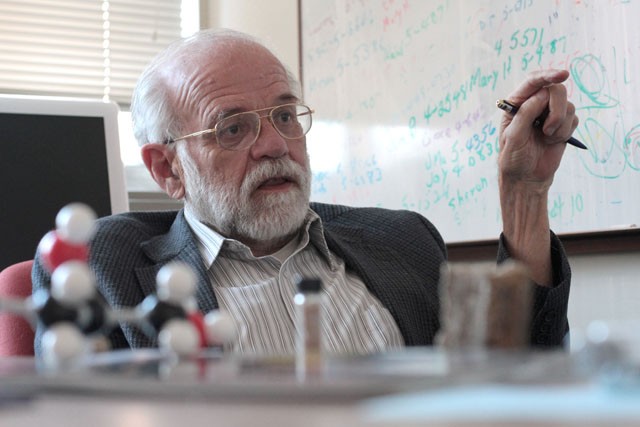A breakthrough in the development of a biofuel could eventually eliminate the need for foreign oil, according to University of Minnesota researchers.
The team recently discovered how to use a protein to get hydrocarbons âÄî the main component in fossil fuel âÄî from bacteria.
Led by biochemistry professor Larry Wackett, researchers used a protein to transform fatty acids from bacteria into ketones, which can be converted into hydrocarbons and then into diesel fuel.
âÄúThe key step was figuring out which gene was capable of producing fatty acids and then taking that from one organism and putting it into another and actually seeing it work,âÄù said Jasmine Erickson, a University nutrition student who worked alongside a then-doctoral candidate who made the discovery.
The University is also filing a patent on aspects of the protein, OleA, Wackett said. He said the teamâÄôs knowledge of it can be used to modify the organism to produce more hydrocarbons in larger quantities.
âÄúItâÄôs one thing to understand the enzyme and know how this works,âÄù Wackett said, âÄúbut now to actually do it on a large scale requires some engineering.âÄù
This was only one component of the project, which received a $2.2 million grant from the Advanced Research Projects Agency-Energy (ARPA-E) in the U.S. Department of Energy in October 2009, Wackett said.
Another goal of the project, which is in collaboration with BioCee Inc., a biotechnology company, and Pacific Northwestern National Laboratory, is to make the hydrocarbons in latex films, or catalytic surfaces âÄî âÄúa much more efficient wayâÄù of doing it, Wackett said.
âÄúItâÄôs different than most research,âÄù said Lanny Schmidt, a chemical engineering and materials science professor and one of the projectâÄôs co-investigators. âÄúItâÄôs high-risk, high-reward.âÄù
Schmidt said there are three parts to the project: biology, biotechnology and chemical engineering.
âÄúWeâÄôve got to get the whole chain working,âÄù Schmidt said.
His team changes the hydrocarbons into gasoline or diesel fuel.
He said ARPA-E is interested in making a âÄúself-contained system,âÄù in which gasoline or diesel fuel must be made from sunlight and cheap fuel sources, like sugar or starch âÄî âÄúsome place where you canâÄôt just go to your local Exxon Mobil station and get gasoline.âÄù
The research team uses a bacterium that âÄúfixesâÄù carbon dioxide and sunlight and converts it to sugars, which are then fed to a bacterium that produces hydrocarbons, Erickson said. She said the plan is beneficial because it takes carbon dioxide, a greenhouse gas, from the atmosphere.
She said the research team is now trying to work out âÄúall these little kinks.âÄù
âÄúItâÄôs not instant gratification by any means,âÄù said Erickson, who began working on the project in WackettâÄôs lab in June 2010. But she said they are capable of doing it.
âÄúWeâÄôll have a very, very novel pathway that is capable of taking things that are just regularly occurring and turning them into something thatâÄôs useful for us,âÄù Erickson said, âÄúwhich is the diesel fuel.âÄù
In order to reach a similar outcome as the University, a research team at Iowa State University, led by biology professor Martin Spalding and also funded by an ARPA-E grant, has made progress using a different approach.
âÄúIâÄôm very optimistic that either WackettâÄôs group or our group or any number of other people that are working in this same area across the country are going to be producing biofuel at least at a scale that shows it will work,âÄù Spalding said, âÄúcertainly in less than a decade.âÄù
He said oil-price increases, national security issues and potential job generation in the industry have encouraged funding and interest in the success of biofuel development before itâÄôs geologically necessary.
âÄúPlus,âÄù Spalding said, âÄúthe environmental concerns about carbon dioxide and global warming are all pushing in the same direction.âÄù

Image by Joe Michaud-Scorza
U researchers looking at bacteria see new biofuels
A breakthrough in the development of a biofuel could eventually eliminate the need for foreign oil.
by Jill Jensen
Published March 30, 2011
0

